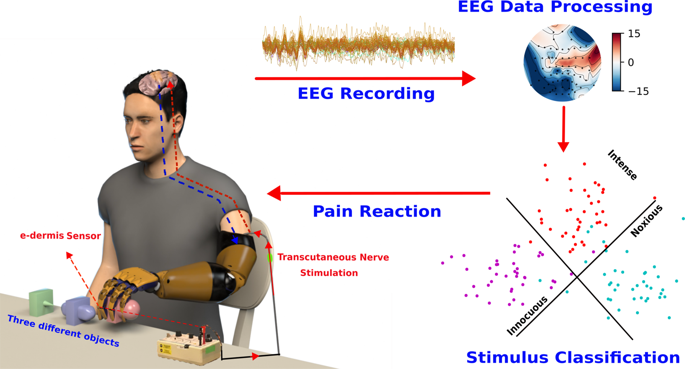Scientific Reports ( IF 3.8 ) Pub Date : 2020-03-27 , DOI: 10.1038/s41598-020-62525-7 Zied Tayeb 1 , Rohit Bose 2, 3 , Andrei Dragomir 2, 4 , Luke E Osborn 5, 6 , Nitish V Thakor 5, 7 , Gordon Cheng 1

|
In recent times, we have witnessed a push towards restoring sensory perception to upper-limb amputees, which includes the whole spectrum from gentle touch to noxious stimuli. These are essential components for body protection as well as for restoring the sense of embodiment. Notwithstanding the considerable advances that have been made in designing suitable sensors and restoring tactile perceptions, pain perception dynamics and its decoding using effective bio-markers, are still not fully understood. Here, using electroencephalography (EEG) recordings, we identified and validated a spatio-temporal signature of brain activity during innocuous, moderately more intense, and noxious stimulation of an amputee’s phantom limb using transcutaneous nerve stimulation (TENS). Based on the spatio-temporal EEG features, we developed a system for detecting pain perception and reaction in the brain, which successfully classified three different stimulation conditions with a test accuracy of 94.66%, and we investigated the cortical activity in response to sensory stimuli in these conditions. Our findings suggest that the noxious stimulation activates the pre-motor cortex with the highest activation shown in the central cortex (Cz electrode) between 450 ms and 750 ms post-stimulation, whereas the highest activation for the moderately intense stimulation was found in the parietal lobe (P2, P4, and P6 electrodes). Further, we localized the cortical sources and observed early strong activation of the anterior cingulate cortex (ACC) corresponding to the noxious stimulus condition. Moreover, activation of the posterior cingulate cortex (PCC) was observed during the noxious sensation. Overall, although this is a single case study, this work presents a novel approach and a first attempt to analyze and classify neural activity when restoring sensory perception to amputees, which could chart a route ahead for designing a real-time pain reaction system in upper-limb prostheses.
中文翻译:

使用脑电图信号解码假肢实时反射系统的疼痛感知:案例研究。
近年来,我们目睹了上肢截肢者恢复感官知觉的努力,其中包括从轻柔触摸到有害刺激的整个范围。这些是身体保护和恢复体现感的重要组成部分。尽管在设计合适的传感器和恢复触觉感知方面已经取得了相当大的进步,但疼痛感知动力学及其使用有效生物标记物的解码仍然没有被完全理解。在这里,我们利用脑电图 (EEG) 记录,识别并验证了使用经皮神经刺激 (TENS) 对截肢者幻肢进行无害、中等强度和有害刺激期间大脑活动的时空特征。基于时空脑电图特征,我们开发了一种检测大脑疼痛感知和反应的系统,成功分类了三种不同的刺激条件,测试准确率达到94.66%,并研究了大脑对感觉刺激的皮层活动反应。这些条件。我们的研究结果表明,有害刺激会激活前运动皮层,在刺激后 450 毫秒到 750 毫秒之间,中央皮层(Cz 电极)的激活程度最高,而中等强度刺激的最高激活程度则出现在顶叶波瓣(P2、P4 和 P6 电极)。此外,我们定位了皮质源,并观察到与有害刺激条件相对应的前扣带皮层(ACC)的早期强烈激活。此外,在有害感觉期间观察到后扣带皮层(PCC)的激活。总的来说,虽然这是一个单一的案例研究,但这项工作提出了一种新颖的方法,也是对截肢者恢复感觉知觉时的神经活动进行分析和分类的首次尝试,这可以为设计上肢实时疼痛反应系统指明道路。 - 假肢。











































 京公网安备 11010802027423号
京公网安备 11010802027423号